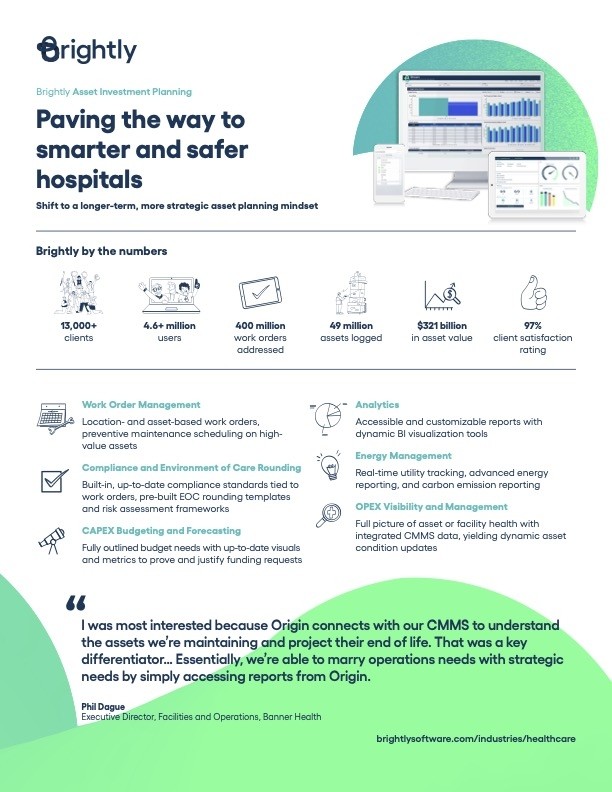What is a CMMS: Computerized Maintenance Management System
What is a CMMS?
A CMMS, or computerized maintenance management system, is software that makes scheduling and tracking maintenance work orders faster, easier, and more cost-effective.
Alternate terms you may hear are maintenance management software and work order software.
What does a CMMS do?
A CMMS is designed to support Maintenance and Operations teams in organizations that rely on physical infrastructure, to make them more informed, more productive, and more profitable. It can help with everything from tracking work orders to scheduling preventive maintenance to managing inventory, and more. A CMMS is an invaluable resource for tasks like:
Asset registry & management
- Track any asset to any level of granularity
- Site>location>sub-location>sub-sub-location, etc.
- Asset>sub-asset(s)>bill of materials (parts)
- Manage all key fields (make, model, serial #, asset #, category, purchase info, emergency info, warranty and much more – including custom fields)
- Review/manage cost-related information based on associated work orders for every asset, including summarizing by category, etc.
Materials & inventory management
- Manage any spare parts and have access to critical data such as part information, location, purchase data, quantity (on hand, on order, reserved, back-ordered, etc.), and more
- Receive notifications if you are low on parts (email, dashboard, etc.)
- Manage requisitions/purchase orders (procurement) lifecycle including dynamic approvals if needed
Work order and resource/labor management
- A CMMS enables supervisors to:
- See your work orders as well as your team’s (same PM/CM, late, etc.)
- Build custom views to manage your team, exposing key work order fields
- Look at historical lists of work orders and associated reporting to show team effectiveness
- Use KPIs, charts, and similar datasets to make sure you are on target with your goals
- Manage the parts for WOs – availability, costs, etc.
- Use available reporting to analyze associated maintenance costs, metrics, trends, etc
- A CMMS enables technicians to:
- Easily see a summary of all of your work (PM/CM, late WOs, etc.)
- Build custom lists of work orders where you show all key fields.
- Example: A typical default view for a maintenance tech would include all “open” work orders, sorted by properly calculated criticality and include all key fields (asset, location, expected date, much more).
Asset maintenance operations & asset life monitoring
- Stretch the life of assets by building robust preventive maintenance (PM) plans
- Identify which assets are causing major issues and work to remedy them
- Utilize a variety of reports to analyze asset effectiveness, like:
- Trend Analysis: This report is for a single asset and shows key data regarding who has worked on the asset, frequency of failure trends, maintenance costs trends, and other similar information.
- Asset Life Cycle Analysis: This report shows numerous assets and grades each on (A-F) based on a combination of work order frequency of failure, cost trends, life of asset, etc.
- Locate “bad actors” through various analytics. See where a high frequency of corrective maintenance work orders based on numerous fields (category, problem code, cause code, etc.) fall.
Preventive maintenance
- Build a comprehensive PM plan based on one-off events, either calendar-based (daily/weekly/monthly, etc.) or usage-based (also called “meter readings” - hours run, cycle count, widgets produced, etc.)
- Establish condition-based monitoring (CBM) PMs (temperature, pressure, vibration, etc.)
- Have the ability to build comprehensive PMs/streamline around groups of assets, production lines, etc.
- Build detailed PM tasks/instructions, including tasks, pictures, videos, documents, etc.
- Turbocharge with IoT (internet of things) integration
Reporting & analysis
- Use graphs, KPIs, and automated reports to notify your maintenance teams, leaders, and others (board of directors) of work that has been done, work that needs to be done and related budget needs
Access an analytics dashboard to see progress on KPIs
Several CMMS providers (like Brightly) offer a cloud-based CMMS software product, which ensures you, as well as your maintenance and facility management teams, are on the latest CMMS technology version which reduces IT impacts of installations, managing servers, and data backups.
Why should you use a CMMS?
If your current asset management and maintenance workflows are disorganized or tedious, a CMMS can make your life easier by automating processes, improving communication between teams, and increasing the overall utilization and lifespan of your assets and equipment.
Implementing a CMMS can enable you to:
Increase work order efficiency
- Find the right person with the right skills and t availability to complete your work order
- Properly balance priority – not just on a single work order, but by including the criticality of the asset as well (we call this “calculated criticality”)
- Route and escalate work orders more strategically, based on current conditions, shifting priorities, etc.
Save time on maintenance tasks
- Simplify instruction via optional associated files like videos, pictures, documents, links, etc.
- Accelerate data entry with a streamlined work order form
- Create, modify, and close work orders with your mobile device for real-time updates
Streamline communication
- Receive automatic notification of work order assignments via AE dashboard, mobile chime, email, etc.
- Implement intelligent routing and notifications with dynamic conditions. For example: Any work order created for Asset X can be automatically assigned to Terry Technician or Corey Contractor since they are the associated expert(s) on that asset.
Save money with improved preventive maintenance and asset management
- Extend the life of the assets to help you avoid capital expenses
- Improve the quality of production (reduce “scrap/rework”) due to well-maintained assets
- Consume fewer parts and energy, and create less waste
Improve communication and transparency across your maintenance team
- Use a dashboard to highlight pending work, statuses of trackable KPIs, parts in low supply, etc.
- Utilize a mobile app to open, close, assign, and otherwise manage work orders right in the field. Real-time updates streamline communication and shorten response times.
Enhance workflow visibility and workforce management
- Implement dynamic routing, workflow, and configuration options through numerous administrative features, including custom statuses, approvals, notifications, etc.
Improve accessibility and customization of reports
- Receive pre-prepared reports and charts with the ability to use the report designer to customize
- Set customizable key performance indicators (KPIs)
- Use “Analyzer tool” for pivot-grid ad-hoc analysis/reporting capabilities
- See analytics, forecasting, and predictive maintenance in one place
Enhance safety programs
- Keep track of all safety-related documentation – lock-out/tag-out procedures, job safety analysis documents, standard safety procedures (PPE, COVID-19, etc.), Safety Data Sheets
- Establish reviewers, expirations, etc. on all safety programs
- Associate to any work order (PM or CM) or use as a generic safety library
Manage compliance more easily
- Core features required by numerous compliance organizations (ISO, OSHA, etc.), including:
- Record preventive maintenance tasks on key assets
- Document/verify work procedures
- Verify safety inspections (proper and on schedule)
- Repair or replace malfunctioning equipment
- Reports/documentation for audits
- Track employee health and safety, trainings and certifications
- Archive work maintenance history
- Document incidents
Automate work and systems
- See examples above around routing, workflow, notification, etc
Who can benefit from a CMMS?
Computerized Maintenance Management Software isn’t just for IT professionals. In fact, if you can search or shop online, or use a smartphone app, then you have the core skills to use a CMMS.
Many industries can benefit from the use of a CMMS as well, including:
- Education (K-12, independent, and higher education)
- Local government
- Manufacturing (oil and gas; food and beverage; automotive; paper, plastics and rubber)
- Healthcare (hospitals, medical equipment, doctor's offices, etc.)
- Senior living
- Clubs and associations (nonprofits, religious organizations, country clubs, YMCAs)
- Other industries (such as zoos and aquariums, hotels, etc.)
No matter your industry, or your experience with software solutions, a CMMS can help you achieve your organizational goals, and Brightly has one of the most user-friendly and intuitive CMMS options on the market.
What does implementing a CMMS look like?
While implementation times may vary, in many cases, you can start to see the value of a CMMS within hours of use. This is especially true if you take advantage of additional professional services such as training, consulting, data migration, help desks, etc.
In terms of resources needed, the size of your organization and the level of detail you wish to track with your CMMS will determine this answer. The beauty of an online CMMS is that it enables you to "crowdsource" information from across your organization, by allowing key members of your team to enter or update existing data, combined with pre-set schedules or templates to autogenerate data.
By starting with a crawl/run/walk mentality, you can start to see progress right away that will continue to grow into true optimization of your maintenance operations team. A positive return on investment can happen within just a few weeks or months, and over time this productivity and profitability can grow exponentially as your CMMS helps you evolve from a firefighting/corrective maintenance mode into a smoother, more proactive, and more optimized state.
How to choose the CMMS that’s right for you
When choosing a CMMS, it’s important to consider the company or partner you will be working with. You should make sure they have a history of offering exceptional products and a strong support team.
At Brightly, we have 12,000+ clients using our CMMS, with a 97% client satisfaction rate. Much of that success is due to our refined and highly streamlined implementation and communication process for new CMMS clients -- all led by our Client Services team who guide you through the implementation process by assessing your needs, prioritizing a list of what should occur when and how, planning a cadence of tasks and communication, executing that plan, then maintaining your success with continual support.
The specific steps within that process include an orientation call, data collection and review; team training, product and feature training; and then help releasing the software to your organization. Once your CMMS is live, you will be assigned to a Client Success Representative to contact when you need help and to review your goals periodically.
If you're interested in seeing how a CMMS could help you own your operations, schedule a personalized demo today! Or take a look at some of our CMMS success stories.


.png?itok=uwNs9CXp)

